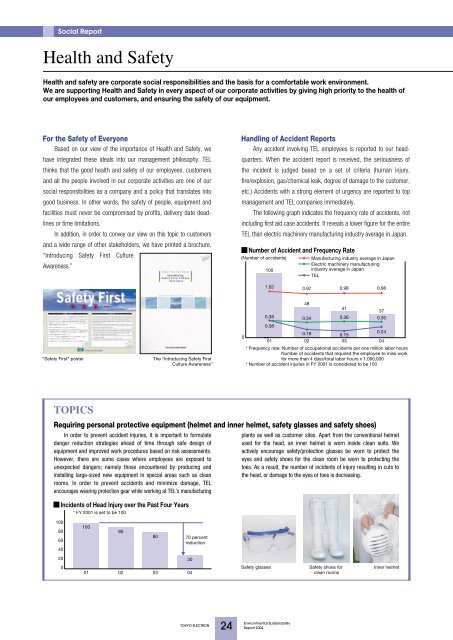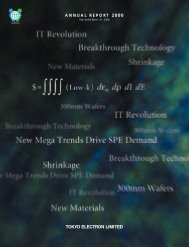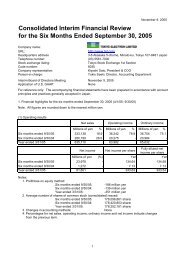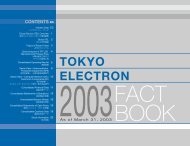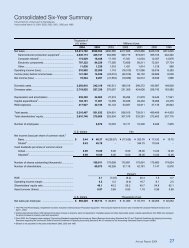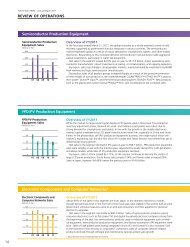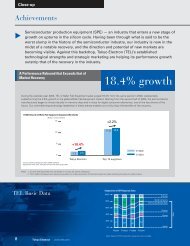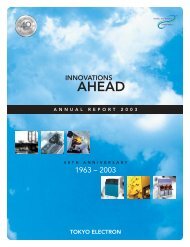PDF (815KB) - Tokyo Electron Limited (TEL)
PDF (815KB) - Tokyo Electron Limited (TEL)
PDF (815KB) - Tokyo Electron Limited (TEL)
You also want an ePaper? Increase the reach of your titles
YUMPU automatically turns print PDFs into web optimized ePapers that Google loves.
Social Report<br />
Health and Safety<br />
Health and safety are corporate social responsibilities and the basis for a comfortable work environment.<br />
We are supporting Health and Safety in every aspect of our corporate activities by giving high priority to the health of<br />
our employees and customers, and ensuring the safety of our equipment.<br />
For the Safety of Everyone<br />
Based on our view of the importance of Health and Safety, we<br />
have integrated these ideals into our management philosophy. <strong>TEL</strong><br />
thinks that the good health and safety of our employees, customers<br />
and all the people involved in our corporate activities are one of our<br />
social responsibilities as a company and a policy that translates into<br />
good business. In other words, the safety of people, equipment and<br />
facilities must never be compromised by profits, delivery date deadlines<br />
or time limitations.<br />
In addition, in order to convey our view on this topic to customers<br />
and a wide range of other stakeholders, we have printed a brochure,<br />
“Introducing Safety First Culture<br />
Awareness.”<br />
Handling of Accident Reports<br />
Any accident involving <strong>TEL</strong> employees is reported to our headquarters.<br />
When the accident report is received, the seriousness of<br />
the incident is judged based on a set of criteria (human injury,<br />
fire/explosion, gas/chemical leak, degree of damage to the customer,<br />
etc.) Accidents with a strong element of urgency are reported to top<br />
management and <strong>TEL</strong> companies immediately.<br />
The following graph indicates the frequency rate of accidents, not<br />
including first aid case accidents. It reveals a lower figure for the entire<br />
<strong>TEL</strong> than electric machinery manufacturing industry average in Japan.<br />
Number of Accident and Frequency Rate<br />
(Number of accidents)<br />
100<br />
Manufacturing industry average in Japan<br />
Electric machinery manufacturing<br />
industry average in Japan<br />
<strong>TEL</strong><br />
1.02<br />
0.97<br />
0.98<br />
0.98<br />
“Safety First” poster<br />
The “Introducing Safety First<br />
Culture Awareness”<br />
0<br />
0.38<br />
0.38<br />
48<br />
0.34<br />
41<br />
0.36<br />
0.18<br />
0.15<br />
01 02 03<br />
0.35<br />
0.24<br />
* Frequency rate: Number of occupational accidents per one million labor hours<br />
Number of accidents that required the employee to miss work<br />
for more than 4 days/total labor hours x 1,000,000<br />
* Number of accident injuries in FY 2001 is considered to be 100<br />
37<br />
04<br />
TOPICS<br />
Requiring personal protective equipment (helmet and inner helmet, safety glasses and safety shoes)<br />
In order to prevent accident injuries, it is important to formulate<br />
danger reduction strategies ahead of time through safe design of<br />
equipment and improved work procedures based on risk assessments.<br />
However, there are some cases where employees are exposed to<br />
unexpected dangers; namely those encountered by producing and<br />
installing large-sized new equipment in special areas such as clean<br />
rooms. In order to prevent accidents and minimize damage, <strong>TEL</strong><br />
encourages wearing protection gear while working at <strong>TEL</strong>’s manufacturing<br />
Incidents of Head Injury over the Past Four Years<br />
* FY 2001 is set to be 100<br />
plants as well as customer sites. Apart from the conventional helmet<br />
used for the head, an inner helmet is worn inside clean suits. We<br />
actively encourage safety/protection glasses be worn to protect the<br />
eyes and safety shoes for the clean room be worn to protecting the<br />
toes. As a result, the number of incidents of injury resulting in cuts to<br />
the head, or damage to the eyes or toes is decreasing.<br />
100<br />
80<br />
60<br />
40<br />
100<br />
90<br />
80<br />
70 percent<br />
reduction<br />
20<br />
0<br />
01 02 03<br />
04<br />
30<br />
Safety glasses<br />
Safety shoes for<br />
clean rooms<br />
Inner helmet<br />
TOKYO ELECTRON<br />
24<br />
Environmental Sustainability<br />
Report 2004


